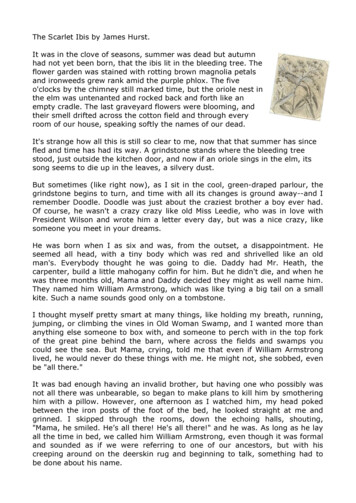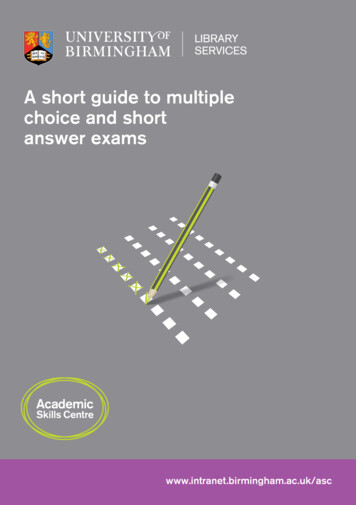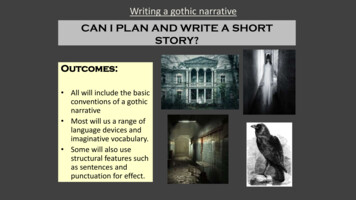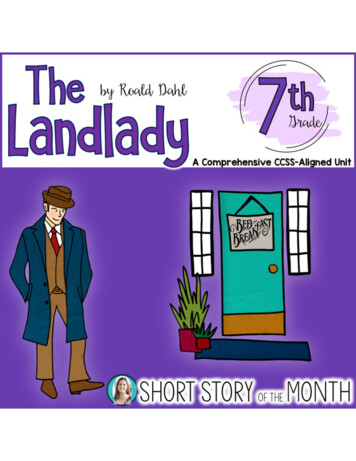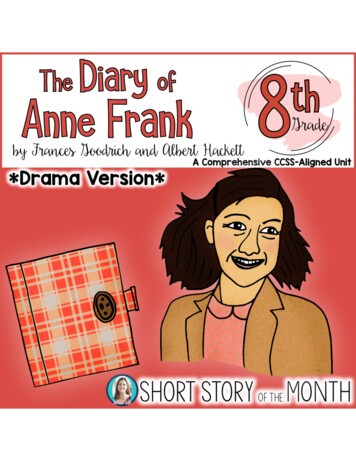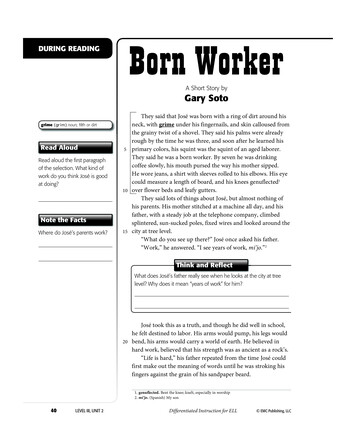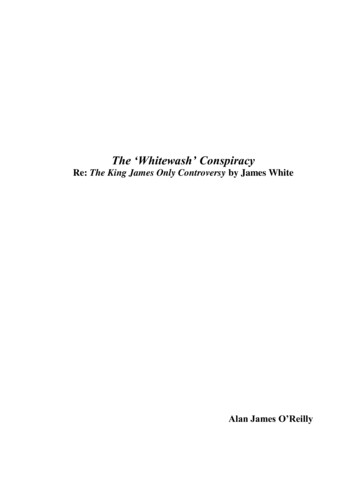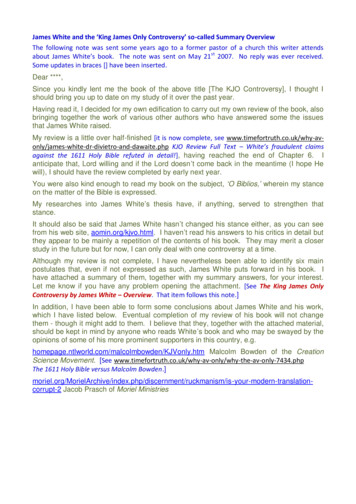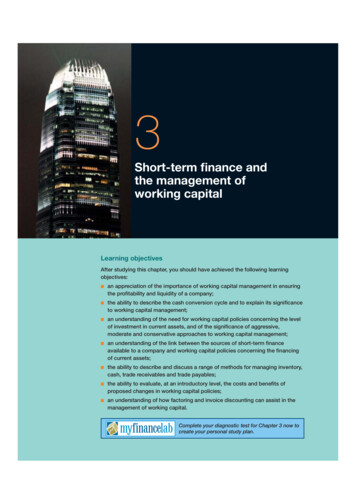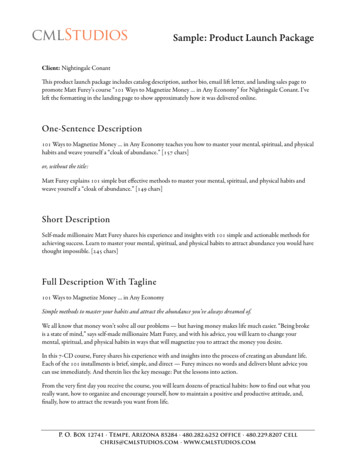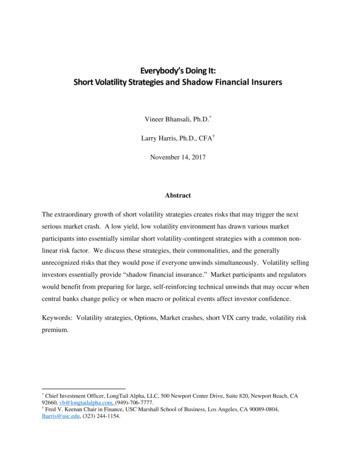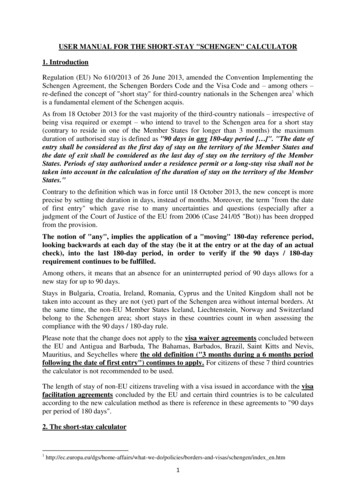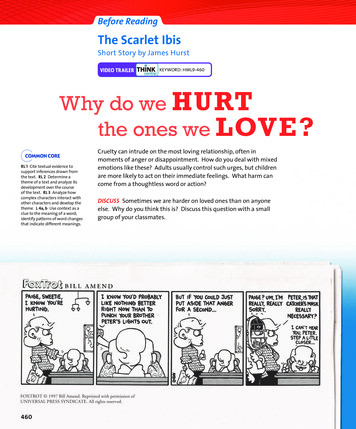
Transcription
Before ReadingThe Scarlet IbisShort Story by James HurstVIDEO TRAILERKEYWORD: HML9-460Why do we HURTthe ones we LOVE ?RL 1 Cite textual evidence tosupport inferences drawn fromthe text. RL 2 Determine atheme of a text and analyze itsdevelopment over the courseof the text. RL 3 Analyze howcomplex characters interact withother characters and develop thetheme. L 4a, b Use context as aclue to the meaning of a word;identify patterns of word changesthat indicate different meanings.Cruelty can intrude on the most loving relationship, often inmoments of anger or disappointment. How do you deal with mixedemotions like these? Adults usually control such urges, but childrenare more likely to act on their immediate feelings. What harm cancome from a thoughtless word or action?DISCUSS Sometimes we are harder on loved ones than on anyoneelse. Why do you think this is? Discuss this question with a smallgroup of your classmates.FOXTROT 1997 Bill Amend. Reprinted with permission ofUNIVERSAL PRESS SYNDICATE. All rights reserved.460
Meet the Authortext analysis: symbolA symbol is a literary device in which a person, animal, place,object, or activity stands for something beyond itself. Writersuse symbols to emphasize important ideas and character traitsin a story, which can act as clues to the story’s theme. In “TheScarlet Ibis,” for example, a swamp comes to symbolize thelove between two brothers. To identify other symbols in thisstory, use these strategies as you read: Look for ideas that the writer emphasizes. Note striking images and character descriptions. Ask yourself what associations each one brings to mind.Review: Mood, Themereading skill: make inferences aboutcharactersWhen you make an inference, you make a logical guess basedon observations or evidence and on your own knowledge andexperience. Sometimes called “reading between the lines,”making inferences is an essential step in understanding theme,characters, and the story itself. Use a chart like the one shownto record evidence from the text and your inferences about therelationship between the narrator and his brother.Quotations and EvidenceInferences About Relationship“Doodle . . . was a nice crazy, likesomeone you meet in your dreams”.Narrator basically liked hisbrother, but thought he was odd.vocabulary in contextThe following boldfaced words are important to understanding“The Scarlet Ibis.” To see which words you already know, restateeach phrase, using a different word for the boldfaced word.1. exotic flowers from the tropics2. reiterate your idea for emphasisJames Hurstborn 1922A Man of Many TalentsJames Hurst lives near the North Carolinacoast, not far from the farm where he wasborn. After attending college and serving inthe U.S. Army during World War II, he studiedsinging at New York’s famous Juilliard School.Hoping for an operatic career, he also studiedin Rome, Italy, but soon gave up on this goal.Then, in 1951, he settled into a long career at alarge New York bank.A Tribute to the Human SpiritDuring his early years at the bank, Hurstpublished short stories and a play. “TheScarlet Ibis” received national attention afterappearing in the Atlantic Monthly in July1960 and winning the Atlantic First awardthat same year. When asked about themeaning of the story, Hurst once replied, “Ihesitate to respond, since authors often donot understand what they write. That is whywe have critics. I venture to say, however,that it comments on the tenacity and thesplendor of the human spirit.”background to the storyDrawn from Nature“The Scarlet Ibis” takes its title from a tropicalbird rarely found in coastal North Carolina,where the story takes place. The lush naturalenvironment of this setting is prominent inthe story. In addition to the ibis, Hurst usesthe local names of plants for the power oftheir symbolic associations. For example,the exotic ibis lands in a “bleeding tree,” atype of pine that oozes a white sap whencut. “Graveyard flowers” are fragrant whitegardenias often planted in cemeteriesbecause they bloom year after year.3. evanesce, like smoke into thin air4. in imminent danger of falling5. claimed infallibility in his deeply-held beliefs6. worked hard and with doggedness7. balanced precariously on the edgeAuthoAuthorOnlineGo to thinkcentral.com.thiKEYWORD: HML9-461KEYWORD8. dangerous beliefs that bordered on heresyComplete the activities in your Reader/Writer Notebook.461
TheScarlet IbisJ a m es H u r s t1020It was in the clove of seasons,1 summer was dead but autumn had not yet beenborn, that the ibis lit in the bleeding tree. The flower garden was stained withrotting brown magnolia petals and ironweeds grew rank amid the purple phlox.The five o’clocks by the chimney still marked time, but the oriole nest in theelm was untenanted and rocked back and forth like an empty cradle. The lastgraveyard flowers were blooming, and their smell drifted across the cotton fieldand through every room of our house, speaking softly the names of our dead. aIt’s strange that all this is still so clear to me, now that that summer has longsince fled and time has had its way. A grindstone stands where the bleedingtree stood, just outside the kitchen door, and now if an oriole sings in the elm,its song seems to die up in the leaves, a silvery dust. The flower garden is prim,the house a gleaming white, and the pale fence across the yard stands straightand spruce. But sometimes (like right now), as I sit in the cool, green-drapedparlor, the grindstone begins to turn, and time with all its changes is groundaway—and I remember Doodle.Doodle was just about the craziest brother a boy ever had. Of course, hewasn’t a crazy crazy like old Miss Leedie, who was in love with PresidentWilson and wrote him a letter every day, but was a nice crazy, like someoneyou meet in your dreams. He was born when I was six and was, from theoutset, a disappointment. He seemed all head, with a tiny body which wasred and shriveled like an old man’s. Everybody thought he was going to die—everybody except Aunt Nicey, who had delivered him. She said he would livebecause he was born in a caul,2 and cauls were made from Jesus’ nightgown.Daddy had Mr. Heath, the carpenter, build a little mahogany coffin for him.But he didn’t die, and when he was three months old, Mama and Daddydecided they might as well name him. They named him William Armstrong,which was like tying a big tail on a small kite. Such a name sounds good onlyon a tombstone. ba MOODWhat words or imagescontribute to the moodof sadness and longingin lines 1–7?What qualities doesthe boy in the paintingseem to have? Pointto details of color, line,shape, and texture tosupport your answer.b M AKE INFERENCESWhat inferences can youmake about Doodle fromthe details offered in thisparagraph? Explain yourthought process.1. the clove of seasons: a time between two seasons, in this case, summer and autumn.2. born in a caul: born with a thin membrane covering the head.462unit 4: theme and symbolRichard at Age Five (1944), AliceNeel. Oil on canvas, 26 14 . Estate of Alice Neel. CourtesyRobert Miller Gallery, New York.
30405060I thought myself pretty smart at many things, like holding my breath,running, jumping, or climbing the vines in Old Woman Swamp, and I wantedmore than anything else someone to race to Horsehead Landing, someone tobox with, and someone to perch with in the top fork of the great pine behindthe barn, where across the fields and swamps you could see the sea. I wanted abrother. But Mama, crying, told me that even if William Armstrong lived, hewould never do these things with me. He might not, she sobbed, even be “allthere.” He might, as long as he lived, lie on the rubber sheet in the center ofthe bed in the front bedroom where the white marquisette curtains billowedout in the afternoon sea breeze, rustling like palmetto fronds.3It was bad enough having an invalid brother, but having one who possiblywas not all there was unbearable, so I began to make plans to kill him bysmothering him with a pillow. However, one afternoon as I watched him, myhead poked between the iron posts of the foot of the bed, he looked straightat me and grinned. I skipped through the rooms, down the echoing halls,shouting, “Mama, he smiled. He’s all there! He’s all there!” and he was. cWhen he was two, if you laid him on his stomach, he began to movehimself, straining terribly. The doctor said that with his weak heart this strainwould probably kill him, but it didn’t. Trembling, he’d push himself up,turning first red, then a soft purple, and finally collapse back onto the bedlike an old worn-out doll. I can still see Mama watching him, her handpressed tight across her mouth, her eyes wide and unblinking. But he learnedto crawl (it was his third winter), and we brought him out of the frontbedroom, putting him on the rug before the fireplace. For the first time hebecame one of us.As long as he lay all the time in bed, we called him William Armstrong,even though it was formal and sounded as if we were referring to one of ourancestors, but with his creeping around on the deerskin rug and beginning totalk, something had to be done about his name. It was I who renamed him.When he crawled, he crawled backward, as if he were in reverse and couldn’tchange gears. If you called him, he’d turn around as if he were going in theother direction, then he’d back right up to you to be picked up. Crawlingbackward made him look like a doodlebug, so I began to call him Doodle, andin time even Mama and Daddy thought it was a better name than WilliamArmstrong. Only Aunt Nicey disagreed. She said caul babies should be treatedwith special respect since they might turn out to be saints. Renaming mybrother was perhaps the kindest thing I ever did for him, because nobodyexpects much from someone called Doodle. dAlthough Doodle learned to crawl, he showed no signs of walking, but hewasn’t idle. He talked so much that we all quit listening to what he said. It wasabout this time that Daddy built him a go-cart and I had to pull him around.3. palmetto fronds: the fanlike leaves of a kind of palm tree.464unit 4: theme and symbolcM AKE INFERENCESCompare the narrator’sinitial reaction to Doodlewith his response toDoodle’s grin. Whatcan you infer about thechange in the narrator’sattitude?d SYMBOLReread lines 60–66. Anickname can sometimesbe a kind of symbol. Whatdoes Doodle’s nicknametell you about the feelingsand expectations othershave for him?
Cypress Swamp, Texas (1940), Florence McClung. Oil on masonite, 24 30 . Gift of the Roger H. Ogden Collection. The Ogden Museum of Southern Art.7080At first I just paraded him up and down the piazza, but then he started cryingto be taken out into the yard, and it ended up by my having to lug himwherever I went. If I so much as picked up my cap, he’d start crying to go withme, and Mama would call from wherever she was, “Take Doodle with you.”He was a burden in many ways. The doctor had said that he mustn’t gettoo excited, too hot, too cold, or too tired and that he must always be treatedgently. A long list of don’ts went with him, all of which I ignored once we gotout of the house. To discourage his coming with me, I’d run with him acrossthe ends of the cotton rows and careen him around corners on two wheels.Sometimes I accidentally turned him over, but he never told Mama. His skinwas very sensitive, and he had to wear a big straw hat whenever he went out.When the going got rough and he had to cling to the sides of the go-cart, thehat slipped all the way down over his ears. He was a sight. Finally, I could seeI was licked. Doodle was my brother and he was going to cling to me forever,no matter what I did, so I dragged him across the burning cotton field to sharewith him the only beauty I knew, Old Woman Swamp. I pulled the go-cartthrough the sawtooth fern, down into the green dimness where the palmettoL 4aLanguage CoachWord DefinitionsWriters sometimesgive clues to a word’smeaning by placing adefinition or examplenearby. Reread lines77–78. What wordsgive you clues to themeaning of careen?the scarlet ibis465
90100110120fronds whispered by the stream. I lifted him out and set him down in the softrubber grass beside a tall pine. His eyes were round with wonder as he gazedabout him, and his little hands began to stroke the rubber grass. Then hebegan to cry.“For heaven’s sake, what’s the matter?” I asked, annoyed.“It’s so pretty,” he said. “So pretty, pretty, pretty.”After that day Doodle and I often went down into Old Woman Swamp.I would gather wildflowers, wild violets, honeysuckle, yellow jasmine,snakeflowers, and water lilies, and with wire grass we’d weave them intonecklaces and crowns. We’d bedeck ourselves with our handiwork and lollabout thus beautified, beyond the touch of the everyday world. Then when theslanted rays of the sun burned orange in the tops of the pines, we’d drop ourjewels into the stream and watch them float away toward the sea. eThere is within me (and with sadness I have watched it in others) a knot ofcruelty borne by the stream of love, much as our blood sometimes bears theseed of our destruction, and at times I was mean to Doodle. One day I took fhim up to the barn loft and showed him his casket, telling him how we all hadbelieved he would die. It was covered with a film of Paris green4 sprinkled tokill the rats, and screech owls had built a nest inside it.Doodle studied the mahogany box for a long time, then said, “It’s not mine.”“It is,” I said. “And before I’ll help you down from the loft, you’re going tohave to touch it.”“I won’t touch it,” he said sullenly.“Then I’ll leave you here by yourself,” I threatened, and made as if I weregoing down.Doodle was frightened of being left. “Don’t go leave me, Brother,” he cried,and he leaned toward the coffin. His hand, trembling, reached out, and whenhe touched the casket he screamed. A screech owl flapped out of the box intoour faces, scaring us and covering us with Paris green. Doodle was paralyzed,so I put him on my shoulder and carried him down the ladder, and even whenwe were outside in the bright sunshine, he clung to me, crying, “Don’t leaveme. Don’t leave me.”When Doodle was five years old, I was embarrassed at having a brother ofthat age who couldn’t walk, so I set out to teach him. We were down in OldWoman Swamp and it was spring and the sick-sweet smell of bay flowers hungeverywhere like a mournful song. “I’m going to teach you to walk, Doodle,”I said.He was sitting comfortably on the soft grass, leaning back against the pine.“Why?” he asked.I hadn’t expected such an answer. “So I won’t have to haul you around allthe time.”“I can’t walk, Brother,” he said.4. Paris green: a poisonous green powder used to kill pests.466unit 4: theme and symboleM AKE INFERENCESDescribe the relationshipthat develops betweenthe brothers. What doyou think is the reasonthat Doodle wins thenarrator over?fTHEMEIn lines 100–102, thenarrator makes a directstatement that offersclues to the theme.Paraphrase the messagehe expresses.
130140150160170“Who says so?” I demanded.“Mama, the doctor—everybody.”“Oh, you can walk,” I said, and I took him by the arms and stood him up.He collapsed onto the grass like a half-empty flour sack. It was as if he had nobones in his little legs.“Don’t hurt me, Brother,” he warned.“Shut up. I’m not going to hurt you. I’m going to teach you to walk.”I heaved him up again, and again he collapsed.This time he did not lift his face up out of the rubber grass. “I just can’t doit. Let’s make honeysuckle wreaths.”“Oh yes you can, Doodle,” I said. “All you got to do is try. Now come on,”and I hauled him up once more.It seemed so hopeless from the beginning that it’s a miracle I didn’t give up.But all of us must have something or someone to be proud of, and Doodle hadbecome mine. I did not know then that pride is a wonderful, terrible thing, aseed that bears two vines, life and death. Every day that summer we went tothe pine beside the stream of Old Woman Swamp, and I put him on his feet atleast a hundred times each afternoon. Occasionally I too became discouragedbecause it didn’t seem as if he was trying, and I would say, “Doodle, don’t youwant to learn to walk?” gHe’d nod his head, and I’d say, “Well, if you don’t keep trying, you’ll neverlearn.” Then I’d paint for him a picture of us as old men, white-haired, himwith a long white beard and me still pulling him around in the go-cart. Thisnever failed to make him try again.Finally one day, after many weeks of practicing, he stood alone for a fewseconds. When he fell, I grabbed him in my arms and hugged him, ourlaughter pealing through the swamp like a ringing bell. Now we knew it couldbe done. Hope no longer hid in the dark palmetto thicket but perched like acardinal in the lacy toothbrush tree, brilliantly visible.“Yes, yes,” I cried, and he cried it too, and the grass beneath us was soft andthe smell of the swamp was sweet.With success so imminent, we decided not to tell anyone until he couldactually walk. Each day, barring rain, we sneaked into Old Woman Swamp,and by cotton-picking time Doodle was ready to show what he could do. Hestill wasn’t able to walk far, but we could wait no longer. Keeping a nice secretis very hard to do, like holding your breath. We chose to reveal all on Octobereighth, Doodle’s sixth birthday, and for weeks ahead we mooned around thehouse, promising everybody a most spectacular surprise. Aunt Nicey saidthat, after so much talk, if we produced anything less tremendous than theResurrection,5 she was going to be disappointed.At breakfast on our chosen day, when Mama, Daddy, and Aunt Nicey werein the dining room, I brought Doodle to the door in the go-cart just as usualand had them turn their backs, making them cross their hearts and hope tog M AKE INFERENCESWhy does the narratortry so hard to teachDoodle to walk? Pointout statements in lines141–148 that supportyour answer.imminent (GmPE-nEnt)adj. about to occur5. the Resurrection: the rising of Jesus Christ from the dead after his burial.the scarlet ibis467
180190200die if they peeked. I helped Doodle up, and when he was standing alone I letthem look. There wasn’t a sound as Doodle walked slowly across the room andsat down at his place at the table. Then Mama began to cry and ran over tohim, hugging him and kissing him. Daddy hugged him too, so I went to AuntNicey, who was thanks praying in the doorway, and began to waltz her around.We danced together quite well until she came down on my big toe with herbrogans,6 hurting me so badly I thought I was crippled for life.Doodle told them it was I who had taught him to walk, so everyone wantedto hug me, and I began to cry.“What are you crying for?” asked Daddy, but I couldn’t answer. They didnot know that I did it for myself; that pride, whose slave I was, spoke tome louder than all their voices, and that Doodle walked only because I wasashamed of having a crippled brother. hWithin a few months Doodle had learned to walk well and his go-cart wasput up in the barn loft (it’s still there) beside his little mahogany coffin. Now,when we roamed off together, resting often, we never turned back until ourdestination had been reached, and to help pass the time, we took up lying.From the beginning Doodle was a terrible liar and he got me in the habit. Hadanyone stopped to listen to us, we would have been sent off to Dix Hill.7My lies were scary, involved, and usually pointless, but Doodle’s were twiceas crazy. People in his stories all had wings and flew wherever they wanted togo. His favorite lie was about a boy named Peter who had a pet peacock witha ten-foot tail. Peter wore a golden robe that glittered so brightly that whenhe walked through the sunflowers they turned away from the sun to face him.When Peter was ready to go to sleep, the peacock spread his magnificent tail,enfolding the boy gently like a closing go-to-sleep flower, burying him in thegloriously iridescent, rustling vortex.8 Yes, I must
Scarlet Ibis,” for example, a swamp comes to symbolize the love between two brothers. To identify other symbols in this story, use these strategies as you read: Look for ideas that the writer emphasizes. Note striking images and character descriptions. Ask yourself what associations each one brings to mind. Review: Mood, ThemeFile Size: 1MB
